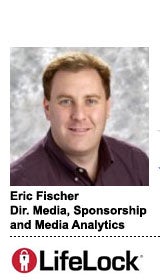 Target’s December data breach, which exposed the credit card and other personal information of as many as 110 million customers in late 2013, was calamitous for Target, scary for its customers, and an “early Christmas present” for identity protection brand LifeLock Inc., according to the company’s head of media.
Target’s December data breach, which exposed the credit card and other personal information of as many as 110 million customers in late 2013, was calamitous for Target, scary for its customers, and an “early Christmas present” for identity protection brand LifeLock Inc., according to the company’s head of media.
But rather than sit back and reel in the inevitable sales windfall guaranteed by the incident, the company’s marketing team sprang into action. It activated a content marketing strategy and fresh ad creative not only for its digital ads but also for some offline placements within about six hours, says Eric Fischer, LifeLock’s director of media, sponsorship and media analytics
Speaking at the Association of National Advertisers (ANA) Media Leadership conference Summit in Boca Raton on Sunday, Fischer recounted how the company seized the real-time marketing opportunity. He also detailed his team’s “double optimization” approach that combines media mix modeling with fractional attribution.
‘Breach’ Targeting
At about 5:45am on December 18, Fischer noticed NBC’s Today Show hosts talking about the story, and saw an opportunity. He immediately had the content marketing team update LifeLock’s owned media channels with information about the breach, and had them create Target-themed messaging for search, social and digital display. More impressive, the company was able to switch out some of its offline media creative within that same timeframe – changing copy associated with its sponsorships of conservative talk radio programs.
“We were able to get Rush Limbaugh, Glenn Beck, and Sean Hannity to change out their live-read copy that day. And our digital was all switched out by noon,” Fischer said. The quick change was more impressive considering legal had to approve all copy, since LifeLock is in a highly regulated industry.
There were no changes that day to TV ad creative, where the company doesn’t have a lot of “breach” oriented creative anyway, “but in what we could affect change in – social, content marketing, radio, digital – in five-and-a-half hours we had pivoted those.”
While LifeLock showed agility in its response to the Target fiasco, a real-time marketing sensibility is only useful if it is matched by solid measurement – an area Fischer is justifiably proud.
‘Double Optimization’
LifeLock was founded in 2006, and offers both enterprise and consumer products. On the enterprise side, it packages credit risk profiles for lenders. For consumers, it offers an identity theft protection service on a monthly subscription model. Customers number about 3 million. Its media mix for these tiered products combines direct response – online and offline – with branding-oriented television ads.
The company stumbled early on when, in 2007 and 2008, it put its CEO’s social security number on billboards and TV ads as proof of product. In the wake of that boast he had his identity stolen a reported 13 times. Since then LifeLock has shifted tactics and messaging, launching a branding campaign in February 2014.
In terms of media mix, the company uses a blend of direct response online, direct response offline, and branding-oriented TV. Fischer’s team deploys a “double optimization” media strategy that incorporates both media mix modeling (MMM) and algorithmic attribution. The company spent much of 2013 evaluating, and then settling on, a MMM partner. It’s now in a similar process with fractional attribution vendors. Data from that vendor will be fed back into the mix models, he said.
“I don’t have an online and offline team,” Fischer said. “I don’t care if we give our money to TV, print, search, or display. I’m agnostic between online and offline.”
Measuring online DR is easy, for reasons every digital marketer knows. Offline DR is trickier, but not impossible. The company relies on “old school, trench-warfare weekly results calls analyzing call center activity, web visits and conversions.” There’s no discussion of downplaying offline media, as the target customer is in his/her 50’s and spends a lot of time with TV.
LifeLock also works with Google to measure the marketing effectiveness of traditional placements such as direct response and brand TV. “We’re taking offline media spend, and we’re layering that on top of search terms, web visits, web conversions, and call center data to measure the impact of offline media,” he said.
Meanwhile television has become more measurable, and TV ad measurement — whether from “people meters,” set-top boxes, or smart TVs – increasingly informs LifeLock’s media mix decisions. “We’re moving in the right direction. Building data platforms to better target and to actually execute [TV campaigns] is very important,” Fischer said.
He noted addressable TV still has the limitation of not being able to accurately measure specific demographics. Household usage, yes; individuals, no.
Commenting on TV prices, Fischer said the goal is to keep brand TV CPMs flat in 2014. Higher cost “premium” spots will be counterbalanced by more “efficient” and “fluid” TV buys.
He said of traditional TV compensation models, “They’ve probably got another five to 10 years of cashing big fat checks before change ruins the old model.”
Asked about LifeLock’s approach to programmatic, Fischer said, “Our [target] niche is 75 million people so it’s a pretty big niche. Programmatically, if we can hyper-target and find those people in our buying,” the company will create advantage.
Fischer said LifeLock’s “always on” approach comes with some disadvantages. “We don’t turn anything off, so it’s hard to isolate variables because we’re never doing one thing in a vacuum.”














